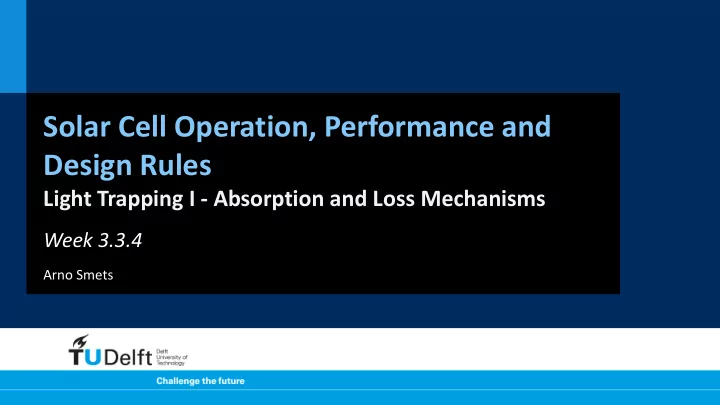

Solar Cell Operation, Performance and Design Rules Light Trapping I - Absorption and Loss Mechanisms Week 3.3.4 Arno Smets
Design Rules Solar Cells 1. Bandgap Utilization Delicate Interplay 2. Spectral Utilization 3. Light Trapping
Light absorption: Lambert- Beer’s law d absorption ( λ ) I 0 intensity I(d) Al
Light absorption: Lambert- Beer’s law ( , ) I x ( ) I ( , x ) x ( , ) ( ) exp( ( ) ) I x I x 0 ( ) expressed in cm -1
Absorption coefficient Absorption coefficient, (cm -1 ) 10 7 GaAs InP 10 6 Germanium 10 5 Silicon 10 4 10 3 10 2 10 1 10 0 200 400 600 800 1000 1200 1400 1600 1800 2000 Wavelength, l (m m) Band gaps
Absorption coefficient 1 Infrared light Normalized intensity [-] 0.8 0.6 Red light 0.4 0.2 0 Blue light 0 20 40 60 80 100 Depth into cell (µm)
Absorption coefficient 10 22 Generation rate (m -3 ) 10 21 10 20 10 19 10 18 10 17 0 50 100 150 200 250 300 Cell depth x (µm) Top solar cell
External quantum efficiency Quantum efficiency 1.0 Wavelength Close to window layer Through entire cell
Parasitic losses = out-side absorbing layers Al Al n+ N+ p-type C-Si P++ P++ Al
Parasitic losses = out-side absorbing layers 1 Al Al Shading 1 n+ N+ p-type C-Si P++ P++ Al
Parasitic losses = out-side absorbing layers 1 2 Shading 1 Al Al Reflection 2 n+ N+ p-type C-Si P++ P++ Al
Parasitic losses = out-side absorbing layers 1 2 3 Shading 1 Al Al Reflection 2 n+ N+ Parasitic absorption 3 p-type C-Si P++ P++ Al
Parasitic losses = out-side absorbing layers 1 2 3 Shading 1 Al Al Reflection 2 n+ N+ Parasitic absorption 3 p-type 4 Transmission C-Si 4 P++ P++ Al
Recommend
More recommend